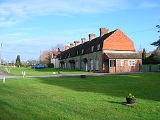
Adversane
Encyclopedia
Adversane is a hamlet
in the Horsham
District of West Sussex
, England
, located 1.5 miles south of Billingshurst
. It consists of a cluster of houses and a public house
(the Blacksmith's Arms) at a crossroads
on the A29 road
, on the Roman road
named Stane Street.
The hamlet was known as Hadfoldshern until the 1850s. The Blacksmith's Arms stands beside the site of the blacksmiths shop, where Gaius (George) Carley was the last of many smiths to work the forge until it closed in the 1960s. He lived at Grigg's Cottage, a half-timbered cottage opposite.
Stane Street cottages, opposite the pub, were probably built using the Roman road as their foundation, as the road deviates slightly at this point, returning to its straight line a little distance further on, and the sandstone houses are precisely in line with both sections of Stane Street. They are in fact a single building, converted in the 1930s from a malt warehouse built by the Allen brothers of Horsham, whose activities are catalogued in 'A History of Horsham' produced by Horsham Museum. They were maltsters who smuggled malt from the continent during the Napoleonic wars and hid their contraband in secret cellars under this and several other warehouses in the Horsham area. The cellars had a tendency to flood and were filled in during the 1950s together with the reputed secret passage to the pub! The malthouse was part of the setting for 'Martin Pippin in the Apple Orchard' by Eleanor Farjeon, published by W. Collins & Sons Ltd in 1921 and by Oxford University Press in 1952.
Hamlet
The Tragical History of Hamlet, Prince of Denmark, or more simply Hamlet, is a tragedy by William Shakespeare, believed to have been written between 1599 and 1601...
in the Horsham
Horsham (district)
Horsham is a local government district in West Sussex, England. Its council is based in Horsham. The district borders those of Crawley, Mid Sussex, Mole Valley, Chichester, Arun and Adur....
District of West Sussex
West Sussex
West Sussex is a county in the south of England, bordering onto East Sussex , Hampshire and Surrey. The county of Sussex has been divided into East and West since the 12th century, and obtained separate county councils in 1888, but it remained a single ceremonial county until 1974 and the coming...
, England
England
England is a country that is part of the United Kingdom. It shares land borders with Scotland to the north and Wales to the west; the Irish Sea is to the north west, the Celtic Sea to the south west, with the North Sea to the east and the English Channel to the south separating it from continental...
, located 1.5 miles south of Billingshurst
Billingshurst
Billingshurst is a village and civil parish in the Horsham District of West Sussex, England. It lies thirteen kilometres south-west of Horsham, and nine kilometres north-east of Pulborough....
. It consists of a cluster of houses and a public house
Public house
A public house, informally known as a pub, is a drinking establishment fundamental to the culture of Britain, Ireland, Australia and New Zealand. There are approximately 53,500 public houses in the United Kingdom. This number has been declining every year, so that nearly half of the smaller...
(the Blacksmith's Arms) at a crossroads
Crossroads (culture)
In folk magic and mythology, crossroads may represent a location "between the worlds" and, as such, a site where supernatural spirits can be contacted and paranormal events can take place...
on the A29 road
A29 road
The A29 is a major road in England. It runs for approximately 34 miles from Capel, south of Dorking, leaving the A24, running through Billingshurst and Pulborough, crossing the South Downs at Bury Hill and passing Fontwell Park Racecourse before terminating on the B2166 on Bognor Regis sea...
, on the Roman road
Roman road
The Roman roads were a vital part of the development of the Roman state, from about 500 BC through the expansion during the Roman Republic and the Roman Empire. Roman roads enabled the Romans to move armies and trade goods and to communicate. The Roman road system spanned more than 400,000 km...
named Stane Street.
The hamlet was known as Hadfoldshern until the 1850s. The Blacksmith's Arms stands beside the site of the blacksmiths shop, where Gaius (George) Carley was the last of many smiths to work the forge until it closed in the 1960s. He lived at Grigg's Cottage, a half-timbered cottage opposite.
Stane Street cottages, opposite the pub, were probably built using the Roman road as their foundation, as the road deviates slightly at this point, returning to its straight line a little distance further on, and the sandstone houses are precisely in line with both sections of Stane Street. They are in fact a single building, converted in the 1930s from a malt warehouse built by the Allen brothers of Horsham, whose activities are catalogued in 'A History of Horsham' produced by Horsham Museum. They were maltsters who smuggled malt from the continent during the Napoleonic wars and hid their contraband in secret cellars under this and several other warehouses in the Horsham area. The cellars had a tendency to flood and were filled in during the 1950s together with the reputed secret passage to the pub! The malthouse was part of the setting for 'Martin Pippin in the Apple Orchard' by Eleanor Farjeon, published by W. Collins & Sons Ltd in 1921 and by Oxford University Press in 1952.

